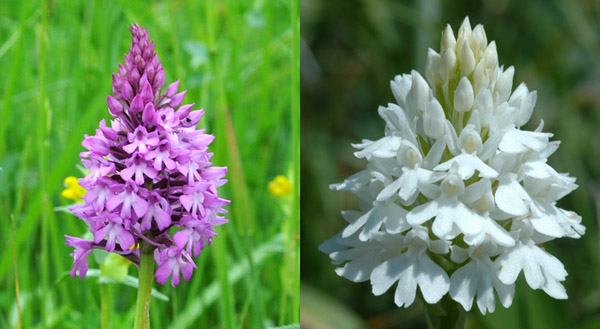Why can we find orchids of one and the same species with different flower colours? The answer depends on the genetic design of a given species.
1. Some orchids have a genetic blueprint which allows flowering in different colours. For example, Dactylorhiza sambucina mostly has yellow flowers, but there are also quite many plants with red flowers. Yellow-flowered plants produce yellow-flowered offsprings and vice versa. But cross-pollination has also produced intermediate colours (Svante Malmgren/Henric Nyström). This colour dimorphism seems to be a characteristic feature of Dactylorhiza sambucina.
2. Colour variation is one of several options how orchids of the same species vary. Species with a great morphological variety often show a broad divergence of flower colours as well – e.g. Anacamptis morio:
3. Beyond this broad spectrum of variations some orchids also show individual genetic characteristics which result in white flowers. These forms are often described as genetical disorders, as an absence of pigments which define the colour of a flower. Terms associated with this phenomenon are hypochromia (in contrast to hyperchromia which means excessive pigmentation, i.e. a very intense colouring) and albiflora. Alba or albiflora forms are devoid of any coloured pigmentation, and are pure white (Olaf Gruss: Albino Forms of the Slipper Orchids. In: Orchid Digest. Vol 69 (4), 2005. p.204). The formation of red flower pigments can be curbed or blocked with some individuals. Flowers with red pigments often have different colour hues – when these pigments are absents, these flowers are white (Wolfgang Wucherpfennig: Die Orchidee des Jahres 2007: das Schwarze Kohlröschen Nigritella nigra subsp. rhellicani, ein Kleinod der Berge. In: Berichte aus den Arbeitskreisen Heimische Orchideen Jg. 24 – Heft 1 – 2007. p.26). An example is the white variation of Anacamptis pyramidalis.
4. Some people describe this individual genetic specialty as albinism: Thus, a plant whose flowers are devoid of any red pigmentation is colloquially termed an albino – these flowers may be light green, yellowish, or white. But in a strict biological sense, an albino is a plant which lacks chlorophyll: Thus, albinism is the complete absence of green pigment that would normally be present. Since most of the orchids presented here have green foliage leaves, they are not albinos, but albiflora forms. Sometimes the white colour dominates just a part of the flower. In other cases the whole flower is pure white, even the pollinia have lost all colour.
Only a plant without any colour pigments, the foliage leaves included, should be named an albino as it has been described with Epipactis helleborine or with Malaxis bayardii in Massachusetts named as Malaxis bayardii forma kelloggiae (Paul Martin Brown: An Albino Adder’s Mouth from Cape Cod, Massachusetts. In: North American Native Orchid Journal, 11/2005. p. 4-5).
There is one common characteristics of albiflora forms and albinism: Both phenomena are genetically recessive – an offspring might retain the white flowers but can also develop flowers in the standard colour. But with some species the white flowered forms are quite common and develop stable populations. With tropical orchids somw white forms have got their own horticultural value and are being cultivated accordingly – with sometimes interesting results. It was, for example, possible to produce a coloured orchid by crossing two albiflora orchids.
Terms like disorder, anomaly or deficiency refer to a certain norm or standard and define the white flowered orchid just by the negative fact of not complying with this norm. This concept with its deprecative connotations shall not to be used here. Instead white flowered orchids of a otherwise coloured species are viewed as special individuals or as way of nature exploring a new path of evolution. The result will be known only in a few million years.


